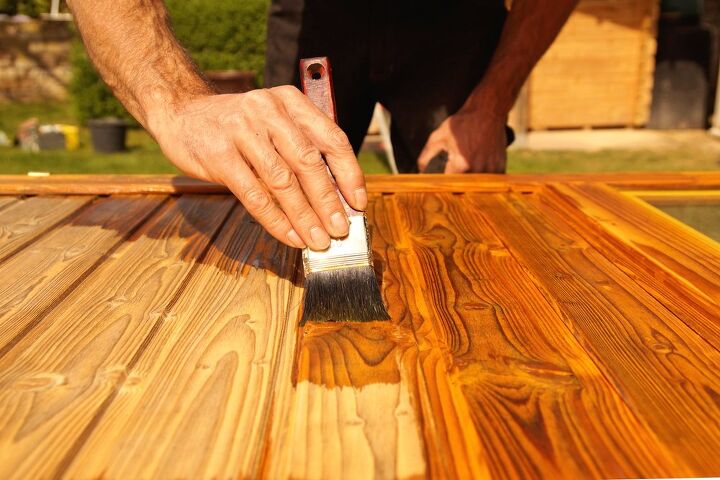Wood Glaze Vs. Wood Stain: What Are The Major Differences?

When you first get into woodworking, you might notice that two terms get thrown around interchangeably: wood stains and wood glazes. At first glance, it’s easy to assume they’re the same. You slap on a coat of the stuff when you are almost done with a project, then the wood looks better. Bada bing, bada boom. Right? Well, not quite. The two aren’t the same.
Wood stains are basically a light coat of paint that has binders that lock it into place. You can paint multiple stain layers on top of each other without having stain stick to the brush. On the other hand, wood glaze has a thicker consistency and can only be used layered between different finish coats. You often need spray-on sealer to lock glaze in, while wood stain can just be left to dry.
Figuring out whether you need a wood glaze or a wood stain is a must, especially if you don’t want a sticky, gloppy mess on your newly finished project. This guide will help you understand what each option offers.
Do You Need to Hire a Paint Contractor?
Get free, zero-commitment quotes from pro contractors near you.

What Is A Wood Stain?
A wood stain is basically a layer of paint that is meant to sink into the wood that you are working with. They are thin, oil-based varnishes that are meant to help lock in a certain color. They are meant to be done with multiple coats. Unlike regular paint, a stain is meant to let you see the natural grain of the wood while also emphasizing the color.
What Is A Wood Glaze?
A wood glaze is a bit different. Glazes offer pigment that still preserves the look of wood grain, but there’s a difference in both the look and consistency. Wood glaze has more pigment and is thicker than a wood stain is. It also meant to work on top of a wood stain, since it is too thick to work well on raw wood. Glazes also can add special effects to your wood.
Wood Stain vs. Wood Glaze: What You Need To Know
Both wood stains and wood glazes have their place in the world of woodworking. However, they are not interchangeable by any means of the word. This will help you learn about each.
The Visual And Texture Effects
Generally speaking, if you want to have a light touch of color, then you need to use a wood stain. Wood glazes are more heavy-handed with their coloring and are meant to help lock in a certain texture or effect. Glazes are best for adding an antique or driftwood look to otherwise standard wood. It is possible to find a clear wood glaze, too.
Wood stains need to have several coats in order to get the full extent of what their color is supposed to look like. Wood stains don’t have any “special effects” type of deal to them. So, they are a lot more versatile when it comes to modern decor. Unlike glazes, stains will always have a color added to them.
How They Work
This is one of the biggest differences between wood stains and wood glazes. Stains are designed to sink into the wood, giving them a nice, treated look. Glazes are there to accentuate wood grains, but they have a tendency of “sitting” on top of the wood. As a result, you are best off using glazes on top of a wood stain.
Glazes are meant to be a ‘float” between different layers of finishing, often acting as a way to add dimension to your wood. So, if you want to use a glaze, you’ll need a bottom coat (a stain, usually) and a sealer on top. If you want to layer your glaze with multiple coats, you will need a coat of sealer over each layer.
Pricing
Wood sealers and wood glazes are actually fairly similar in the base price range, but glazes tend to be more expensive to apply overall. Wood sealer will be $5 to $15 for a single can, while wood glaze will be between $8 to $30 per can. You typically will need to buy more glaze than sealer due to the thickness of the stuff.
Additionally, if you want to use a wood glaze, then you also need to budget for other items that you may need to apply. This includes setting aside extra money for a nice wood stain and getting a wood sealer. In some cases, you may actually be required to add a top coat in order to ensure your wood glaze will stay put. So, don’t actually
Which One To Use
Generally speaking, almost all wood will need to have a stain. However, we can offer better guidelines on how to use them and when they are best. Here’s what you need to know:
- If you want to add a subtle pop of color to your wood, then use a stain. Stains give you better control over the look of your wood since they let you have multiple layers of stain without having to add a finish or a sealer.
- Wood that has very subtle grain may need to have a stain. Stains are good for emphasizing and bringing out the grain of the wood. If you want to bring that texture in, then that’s what you need.
- If you have raw wood, use a stain. Raw wood is not good with a glaze.
- Getting an antique look or trying to upcycle your wood is best done with a glaze. Depending on your project, you might want to get a more weathered look or a more “sealed in” look. Both are best done with a glaze, since they tend to bring out the edginess of certain materials.
- People who want to amplify wood grains that have been brought to the surface should choose a glaze. Glazes are good for bits of wood that have already shown off their grittiness.
- Only use glazing for layers if you have a high-quality wood sealer. Wood glaze sometimes gets used as a “float” between finishes and sealers.
Find out if you can stain green wood.
Which Is Better, A Glaze Or A Stain?
Honestly, this is like comparing apples to oranges. Both have their perks and pitfalls, but the thing is, they are totally different when it comes to usage. The best way to look at this situation is to assume that all glazes need a stain, but not all stains need a glaze. If you are not sure which to use, here’s where they shine:
- Glazes are best for special wood effects or exceptionally bright colors. Glazes are heavy on pigmentation, so if you are looking for a serious pop of color, that’s the one you should buy.
- Stains are good for light touches of color, or projects where you want to have better control over how dark or light wood becomes. The good thing about stains is that they are light and easy to be layered up. This is a good thing if you just want a kiss of color, or if you want to be able to get that perfect shade of blue or chestnut to your home.
- Some craftsmen also use glaze as a way to protect wood from stains from things like water and food. It’s true. Protective glazes are amazing for keeping your stuff looking pristine, especially if you top them with waterproofing sealers. If you want to get more protection but don’t want to add color, then opt for a clear glaze.
A Final Note About Glazes And Stains
If you don’t find a color that works for your project on store shelves, don’t panic. In most cases, you will be able to make your own custom color using an online tutorial or by layering stains and glazes together. While I totally understand that low-key panic that you get when you can’t find that perfect shade, the real issue is finding that perfect tool for the job.
Do You Need to Hire a Paint Contractor?
Get free, zero-commitment quotes from pro contractors near you.

Related Questions
Do you have to seal stained wood?
Most wood stains do not require a sealant. However, if you want to make sure that your wood is going to be more durable and have a nice finish to it, you should get a sealant. The sealant is what gives your wood the fine glossy look and feel of high-quality furniture.
Should you stain or seal a deck?
Honestly, doing both is usually the best thing to do. In most cases, staining a deck is the best thing to do since it can protect your deck from the sun, mold, mildew, and rot. With that said, a nice sealant will also do the same but won’t add that burst of color that people tend to want.
How can you tell if a glaze needs to be sealed?
Glazes generally do better if they have a seal on top. However, if you aren’t sure if it’s 100 percent necessary, there’s a quick fix. The best way to find out if your glaze requires a seal is to look on the package. The instructions will usually tell you what’s needed, and even recommend a seal type for you.
Related Articles

Ossiana Tepfenhart is an expert writer, focusing on interior design and general home tips. Writing is her life, and it's what she does best. Her interests include art and real estate investments.
More by Ossiana Tepfenhart

























![Standard Dining Room Table Dimensions [for 4, 6, 8, 10 and 12 People]](https://cdn-fastly.upgradedhome.com/media/2023/07/31/9074335/standard-dining-room-table-dimensions-for-4-6-8-10-and-12-people.jpg?size=350x220)

